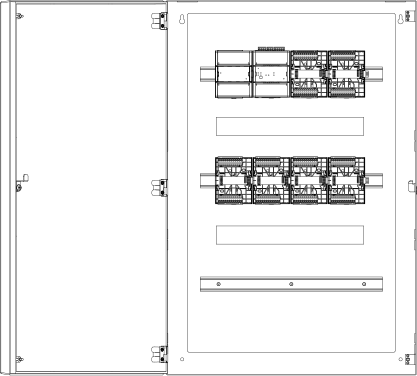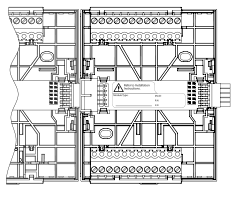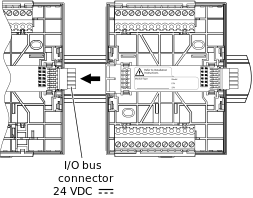
Concetto
Device Installation
The SpaceLogic devices with the two-piece design are designed for installation on DIN rails in a cabinet.
Consider a simple example:

Two-piece design
Each device consists of two parts:
Terminal base
Electronics module

A separate terminal base means the terminal base can be installed and wired before the electronics module with the application program and data is supplied.
The electronics module is easily plugged in to the terminal base and firmly locked by pushing the handles in place.
Replacing an electronics module is done in seconds because no terminal wiring is affected.
Installation orientation restrictions
The terminal base must be installed horizontally with the backplane board device label text in the upright position reading left to right. Any other installation orientations may exceed the electronics module's thermal specifications, which can damage the electronics module.

Installation on a DIN rail
A DIN rail is a common and convenient technique for installing a SpaceLogic device along with other associated control and monitoring devices. The most efficient ventilation is achieved with the wall-mounted DIN rail oriented horizontally and with adequate space provided between the SpaceLogic device rail and adjacent rails or other panel-mounted devices.
The terminal base must be installed on a horizontal DIN rail (going from left to right), with the device label text and the text “UP” (indicated by an arrow) in the upright position reading left to right.
Installing the terminal base on a horizontal DIN rail provides sufficient cooling air flow through the electronics module. Installing the terminal base on a vertical DIN rail can reduce the life span of the electronics module.

The terminal base is recommended to be installed on a DIN rail, but it can also be mounted directly on the wall.
To prevent the modules from sliding sideways on the DIN rail, fix an end clamp for DIN 35 (part number SXWDINEND10001) tightly against the rightmost device on the rail. The end clamp is easily removed if you bend the snap lock open with a screwdriver.

Installation in a cabinet
Install the terminal bases horizontally in the cabinet with ample space between the DIN rails and devices for sufficient cooling air flow through the electronics modules.

Installation of electronics modules on terminal bases
To ensure that the correct electronics module is used with the correct terminal base, you must always check that the warning label on the terminal base backplane indicates which module type is to be connected. Write the intended module type, if it is not already printed, on the label.

Install only the module type that is indicated on the label on the terminal base backplane. A mismatch can cause electric shock and damage the electronics module.
If the label does not indicate the intended module type, consult the control panel documentation to determine the intended module type.
The electronics module is easily plugged in to the terminal base and firmly locked by pushing the handles in place.

Connection of the next terminal base on the I/O bus
The terminal bases are connected to each other by sliding the terminal bases together using the built-in connectors.

The chain of devices can be split on multiple DIN rails (rows) by using an extension cord called S-cable. Maximum five S-cables are allowed per system. The S-cable connects the last (rightmost) device on one DIN rail with the first (leftmost) device on the next DIN rail.
The complete chain of devices must remain within one cabinet for EMC reasons. When the I/O bus size or quantity of I/O modules exceeds the capacity of a single cabinet, you can extend the I/O bus using an S-cable to a second, adjacent cabinet. Both cabinets must be securely fastened together and electrically connected to function as a single unit. This ensures continuous electromagnetic compatibility (EMC) protection, equivalent to that of a single cabinet. Mechanical bonding involves securely fastening the cabinets together, while electrical bonding ensures a common grounding and shielding system, minimizing electromagnetic interference and maintaining signal integrity.
The following figure shows an example of how you can use an S-cable to connect devices that are installed on separate DIN rails in a cabinet. For sufficient cooling air flow through the devices, the DIN rails and the devices are installed horizontally in the cabinet.

The S-cable is available with right angle connectors and in 1.5 m (5 ft) and 0.75 m (2 ft 5 in) lengths. You can serially connect up to two S-cables to extend the length.
The following image shows the minimum space required for plugging/unplugging the S-cable from the device but also provides information on the minimum bend radius required to reduce the stress of the cable. The S-cable with straight connectors is a discontinued product, which can no longer be ordered from Schneider Electric.

Device order
The order in which the devices are installed in the chain (I/O bus) is important. The devices should be installed in the following order:
Position 1 (leftmost): Power supply (mandatory)
Position 2: AS-P server (mandatory)
Position 3 to 32: Central IO modules and extra power supplies as needed based on power budget. One power supply can supply power for loads up to 30 W. Per maggior informazioni, consulta Power Budget .
There is a limit of one automation server per I/O bus.
The rules are summarized in the following illustration.

 Hardware Overview
Hardware Overview
 Terminal Bases
Terminal Bases
 Power Budget
Power Budget
 Installing a Terminal Base on a DIN-rail
Installing a Terminal Base on a DIN-rail
 Connecting Terminal Bases
Connecting Terminal Bases
 Wiring a Terminal Base
Wiring a Terminal Base
 Installing an Electronics Module on a Terminal Base
Installing an Electronics Module on a Terminal Base
 Powering Up a Device
Powering Up a Device
 Allarme
Allarme